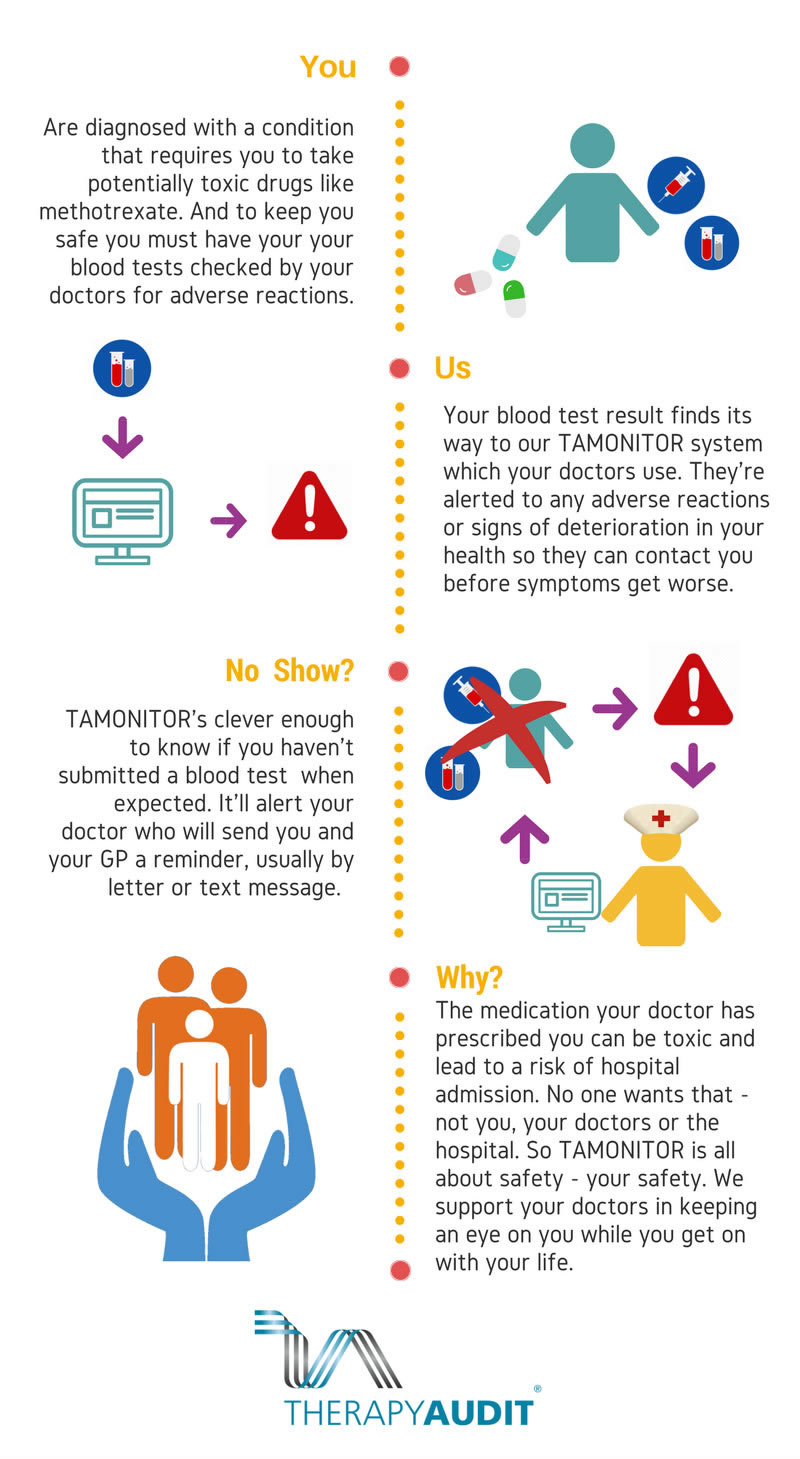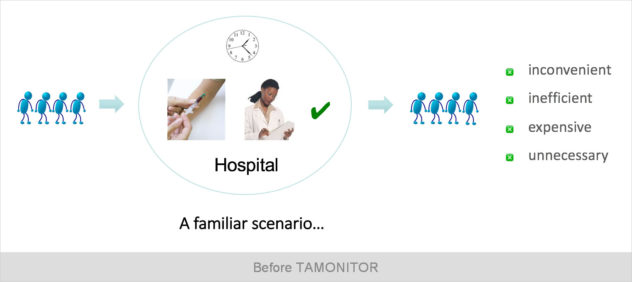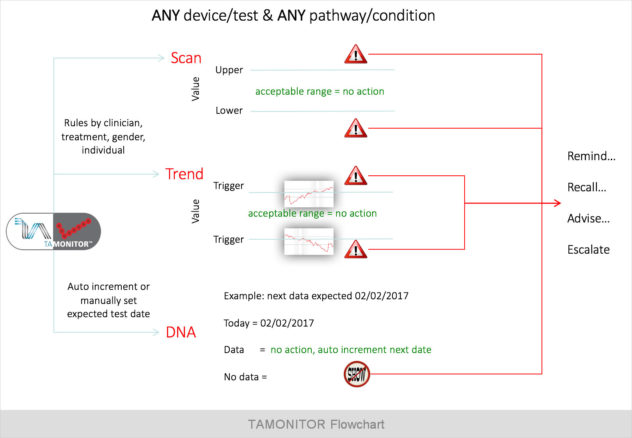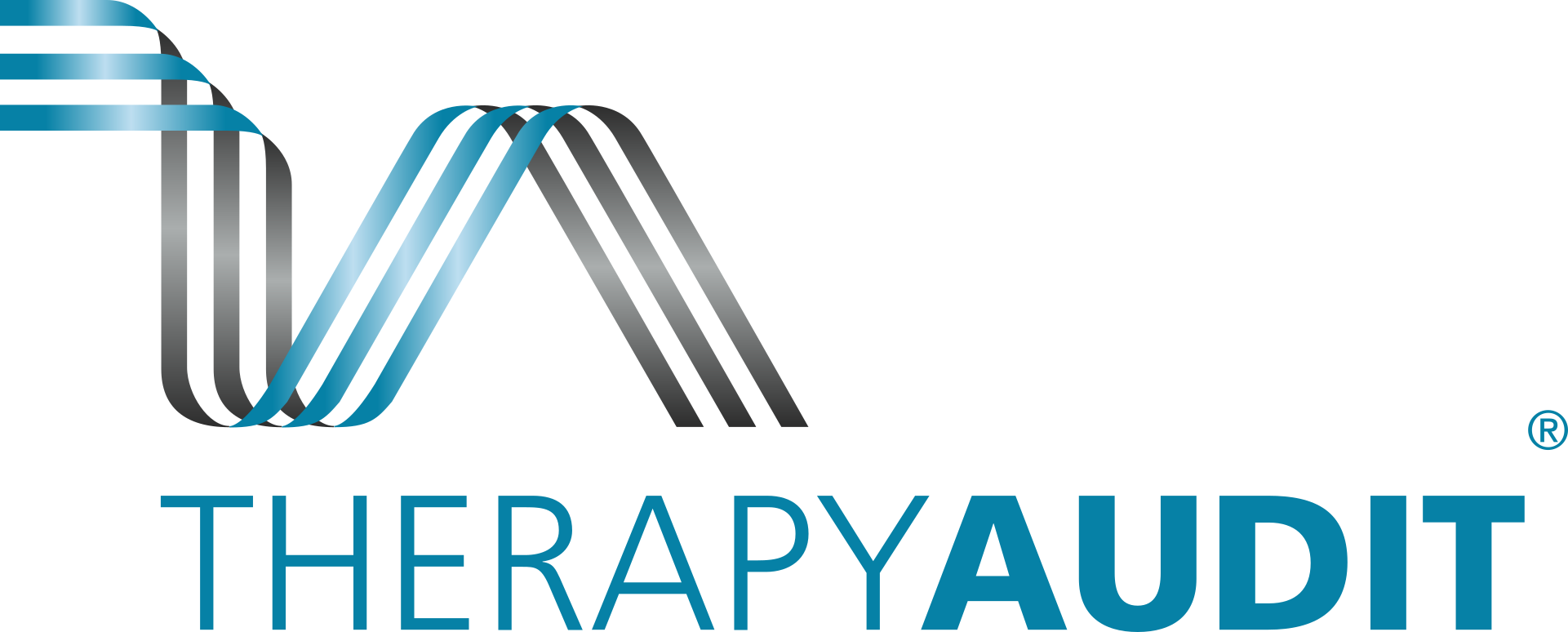



-
Our professional relationship and mutual support has transformed our service to a clinically excellent and efficient one
Dr Clive Kelly, Department of Rheumatology, Queen Elizabeth Hospital, Gateshead
What is TAMONITOR?
TAMONITOR (also known as beetroot DMARD) is a multi-specialty therapeutic blood test monitoring system, and is available for primary and secondary care clinicians. It can provide a complete solution to the clinical governance requirements of therapeutic drug monitoring. TAMONITOR is designed to be as simple and efficient to use as possible. It collects electronic blood results from the laboratory, and stores them in a database. Results can be checked for abnormalities, trend-checked to identify deteriorating conditions, and audited against pre-set frequencies to identify patients who haven’t attended for blood testing when expected. The task of manually creating and amending record cards for patients from paper results is eliminated.
Everything in TAMONITOR is configurable. Lists of drugs, rules associated with them, reasons for cessation of treatment and diagnoses, can be added, changed or removed at will and the text for automatically generated patient and primary care physician letters is very easy to edit.
TAMONITOR even automates the onerous task of populating the patient database. TAMONITOR will automatically identify new patients from received blood results, create a new patient record with as much demographic detail as is supplied in the result, and then prompt to confirm the addition of the patient to the database. In this way, TAMONITOR can be used right from day one, without the need to wait for all patients to be added to the database. We asked Andrew Roberts, TAMONITOR Product Manager, to tell us more.
Why blood test monitoring and TAMONITOR?
 Lots of people need regular blood testing, and the traditional way of doing this has involved them taking time off to go to a hospital or a clinic to have their blood sample taken. Then what? All too often they wait, and wait, and wait, for the sample to be processed and their clinician to check the result, only to find that everything’s OK. And then they go back home or back to work, to wait for the next time they have to make the journey, just to find out they’re OK. This may be familiar, but it’s also inconvenient for the patients, inefficient and expensive for the healthcare provider, and with modern technology, unnecessary. So what did we do about this inefficiency? Many years ago in one of the first TAMONITOR hospitals, rheumatology patients were sent to the community for blood testing instead of the hospital, and that saved more than 5000 outpatient appointments in the first year alone! So people go the community centre, or local GP instead of the hospital to have their blood samples taken. These samples are sent to the Hospital pathology department for processing, and an e-result (electronic copy of the test result) is created and sent to TAMONITOR. By the way, TAMONITOR doesn’t have to be operated by clinicians – a clerical person can share alerts with clinicians as necessary. If there’s no problem with the result no action is taken. If there is a problem an alert is created and made visible to the clinician. Having reviewed the alert the clinician can issue a treatment change or even recall the patient, and if necessary escalate the alert to colleagues like GPs. It’s also worth noting that TAMONITOR usually has a link to the Electronic Health Record which enables it to receive updated demographics and other information about the patient. And finally, in order to help patients to remember to go for their tests TAMONITOR has a built in text message facility which can automatically remind them of their test dates as well as being used for other communication. And the end result of implementing TAMONITOR? More convenient for the patient and more efficient and cheaper for the healthcare provider. Better outcomes all round.
Lots of people need regular blood testing, and the traditional way of doing this has involved them taking time off to go to a hospital or a clinic to have their blood sample taken. Then what? All too often they wait, and wait, and wait, for the sample to be processed and their clinician to check the result, only to find that everything’s OK. And then they go back home or back to work, to wait for the next time they have to make the journey, just to find out they’re OK. This may be familiar, but it’s also inconvenient for the patients, inefficient and expensive for the healthcare provider, and with modern technology, unnecessary. So what did we do about this inefficiency? Many years ago in one of the first TAMONITOR hospitals, rheumatology patients were sent to the community for blood testing instead of the hospital, and that saved more than 5000 outpatient appointments in the first year alone! So people go the community centre, or local GP instead of the hospital to have their blood samples taken. These samples are sent to the Hospital pathology department for processing, and an e-result (electronic copy of the test result) is created and sent to TAMONITOR. By the way, TAMONITOR doesn’t have to be operated by clinicians – a clerical person can share alerts with clinicians as necessary. If there’s no problem with the result no action is taken. If there is a problem an alert is created and made visible to the clinician. Having reviewed the alert the clinician can issue a treatment change or even recall the patient, and if necessary escalate the alert to colleagues like GPs. It’s also worth noting that TAMONITOR usually has a link to the Electronic Health Record which enables it to receive updated demographics and other information about the patient. And finally, in order to help patients to remember to go for their tests TAMONITOR has a built in text message facility which can automatically remind them of their test dates as well as being used for other communication. And the end result of implementing TAMONITOR? More convenient for the patient and more efficient and cheaper for the healthcare provider. Better outcomes all round.
Understand that. but how does it work?
 Like the best technology the hard work’s done in the background. The processing of results can be automated so that a dashboard reports any alerts and DNAs as soon as a user logs in. There are three main functions of TAMONITOR – Scan, Trend and DNA (Did Not Attend – for a blood sample to be taken for checking).
Like the best technology the hard work’s done in the background. The processing of results can be automated so that a dashboard reports any alerts and DNAs as soon as a user logs in. There are three main functions of TAMONITOR – Scan, Trend and DNA (Did Not Attend – for a blood sample to be taken for checking).
Scanning involves checking each value in the test result to see if it’s out of range as defined by rules set up by the clinician. These rules are very flexible and different ones can be set up for individual clinicians, treatments and/or combination therapies, patients by gender or even individual patients. If any of the data is out of range an alert is created and will remain in the system’s dashboard until a TAMONITOR user takes responsibility to dismiss it, recording the action taken. This maintains a comprehensive audit trail and applies to trending and DNAs as well.
Trending looks at cumulative data over time and identifies deteriorating trends in data according to trending rules set up by clinicians. Identifying deteriorating trends early clearly has the potential to avoid inconvenience to the patients and the expense of unnecessary hospitalisation.
The identification of DNAs is especially important when patients are expected to go for blood testing in the community. TAMONITOR calculates the next date of testing from the receipt of the last received test and according to the frequency of testing rules set up by clinicians, on a treatment and/or individual patient basis. If a result is received when expected the next date is automatically recalculated – if not an alert is created and a text message reminder can be sent to the patient.
TAMONITOR and its predecessor has been around for 20 years, any plans to develop it?
 Patients are being encouraged to improve their health and wellbeing by self-managing and self-caring. That makes a lot of sense, but we believe you have to give people the tools to be able to self-manage. So that’s why we created beetroot.
Patients are being encouraged to improve their health and wellbeing by self-managing and self-caring. That makes a lot of sense, but we believe you have to give people the tools to be able to self-manage. So that’s why we created beetroot.
Intended to support the collection of any kind of data from any medical device, beetroot enables people to collect both test data and quality of life data and send it to TAMONITOR via an app or a simple text interface from the convenience of their own home, and at a time of their choosing. Data can be entered manually, or automatically transferred to the app via Bluetooth or wireless enabled equipment. When the data’s received it’s checked in the same way by TAMONITOR, according to rules set up by the clinician. Alerts and DNAs are identified and dealt with, including escalation to other health professionals and stakeholders such as carers. Advice from the clinician such as treatment change can be communicated back to the patient through TAMONITOR and the beetroot app, and through social media patients with similar conditions and circumstances can be connected together to share their experiences, mitigating any risk of social isolation that might be caused by spending more time at home than in the hospital or clinic environment. Integral to the design of beetroot are elements of behaviour change. We recognise that the adoption of technology in people’s lives requires subtle incentives, and that’s why we’re working with behaviouralists to ensure we embed the right motivation at all stages. In this way we believe beetroot can help patients to be more self-caring and connected.
This core functionality within TAMONITOR provides an automated and safe way of monitoring patients in the community living with long term conditions who are at risk of adverse events and deteriorating health. We know it works as it’s been used for many years with many patients – if it didn’t work our clinicians wouldn’t use it. if you need more information about TAMONITOR and beetroot get in touch with us – we’re always happy to spread a good news story.
TAMONITOR QE Gateshead Case Study
Sites
Specialities
Doctors
Nurses
Patients Monitored*
Blood Tests Recorded*
*Last 12 Months
Interested?
If you want to know more about TAMONITOR – call 0800 756 1087 or complete our contact form.


